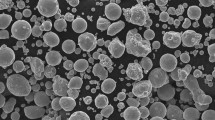Abstract
Thermal conductivity of a powder injection moulding feedstock (mixture of metal powders and polymers) in solid and molten states has been measured by using the laser flash method. The filler material was 316L stainless steel powder and its content in the mixture amounted 60% by volume. An attempt has been made to employ two most promising existing mathematical models (theoretical Maxwell- and semi-theoretical Lewis & Nielsen model) to calculate the thermal conductivity of the mixture. Comparison of the experimental and calculated results has revealed that the Lewis & Nielsen model predicts better than Maxwell model the thermal conductivity of the feedstock. As the difference between the calculated (Maxwell model) and the measured results amounts to 15–85%, it is suggested that it can only be used for preliminary assessment of the thermal conductivity of so highly filled composite material. If accurate thermal conductivity data are required (as in case of numerical simulation of the powder injection moulding process), measurement of this property has to be performed if meaningful simulation results are to be expected.
Similar content being viewed by others
References
M. Dutily and J. C. Gelin, in Proc. of the 1st European Symposium on Powder Injection Moulding – 1997, October 1997, Munich, Germany, ISBN 1 899072 05 5, pp. 170–176.
K. Mori, K. Osakada and S. Takaoka, in “Proc. Of NUMIFORM” 95: Simulation of Materials Processing,” June 1995, Ithaca, USA, edited by S. F. Shen and P. R. Dawson, 1995, pp. 1179–1184.
R. M. German, “Powder Injection Molding, Metal Powder Industries Federation” (Princeton, NY, 1990) p. 183.
A. Witek, O. Guerrero and D. G. Onn, in “Proc. of the 21st Int. Thermal Conductivity Conference,” October 1989, Lexington, USA, edited by C. J. Cremers and H. A. Fine (Plenum Press, NY, 1989) pp. 177–185.
R. C. Progelhof, J. L. Throne and R. R. Ruetsch,Polym. Eng. Sci. 16 (9) (1976) pp. 615–625.
P. G. Klemens and G. Neuer, “Numerical Data and Functional Relationships in Science and Technology,” Vol. 15, subvolume c, Thermal Conductivity of Pure Metals and Alloys (Springer Verlag, Berlin, 1991).
Rights and permissions
About this article
Cite this article
Kowalski, L., Duszczyk, J. & Katgerman, L. Thermal conductivity of metal powder-polymer feedstock for powder injection moulding. Journal of Materials Science 34, 1–5 (1999). https://doi.org/10.1023/A:1004424401427
Issue Date:
DOI: https://doi.org/10.1023/A:1004424401427




